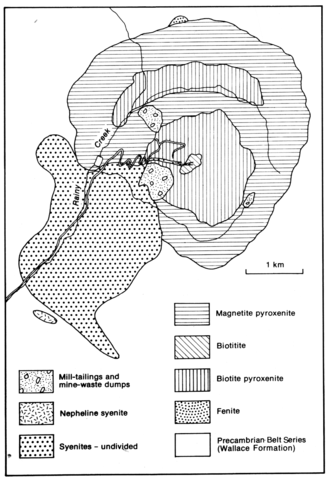stripes
Rainy Creek is an approximately circular, zoned, ultramafic intrusion cut across by a later syenite, the whole emplaced in Precambrian argillites and dolomitic and calcareous argillites of the Belt Series, which are slightly fenitized in places. Exposure is poor, but extensive drilling and quarrying operations have enabled an accurate map to be made (Fig. 127). The zoned part of the complex comprises magnetite and biotite pyroxenite with a much smaller area of biotitite. Magnetite pyroxenite forms the outer zone and is younger than the biotite pyroxenite, apparently having been emplaced in a ring dyke and forming dykes and apophyses that cut the biotite pyroxenite. The magnetite pyroxenite constitutes 42% of the area and consists of up to 70% diopsidic pyroxene, about 10-29% magnetite, up to 9% apatite, and accessory andradite, sphene and biotite or vermiculite. In a small area of orthoclase-bearing pyroxenite the pyroxenes are zoned to aegirine-augite. The biotite pyroxenite covers 18% of the complex and a typical example comprises 60% diopside, 37% vermiculite and 2-5% apatite, but there is wide variation. Irregular areas contain biotite which has been altered to vermiculite. The biotitite, which has a gradational contact with the biotite pyroxenite, consists almost wholly of biotite with accessory alkali feldspar, pyrite, calcite and possible riebeckite. Inclusions within the biotitite appear to have been ultramafic rocks but they are now altered to assemblages including dolomite, phlogopite with reversed pleochroism, magnetite etc. The syenite body in the southwest of the complex is strongly weathered, and has not been investigated in detail, but it probably comprises a number of separate intrusive masses (Larsen and Pardee, 1929, p. 107). Many of the rocks comprise alkali feldspar with interstitial muscovite, which is probably after nepheline. Other variants contain melanite, amphibole, aegirine-augite and quartz. The small area of nepheline syenite in the southwest contains approximately equal volumes of nepheline, albite and microcline with a little aegirine and accessories. All the rocks of the complex are traversed by dykes of alkaline syenite, trachyte-phonolite, pegmatite, alkaline granite and quartz-rich veins. An investigation of the vermiculite, hydrobiotite and biotite at Rainy Creek has been made by Boettcher (1966) and early papers on the geology and mineralogy are referred to in Boettcher (1967).
BOETTCHER, A.L. 1966. Vermiculite, hydrobiotite, and biotite in the Rainy Creek igneous complex near Libby, Montana. Clay Minerals, 6: 283-96.
BOETTCHER, A.L. 1967. The Rainy Creek alkaline-ultramafic igneous complex near Libby, Montana. 1. Ultramafic rocks and fenite. Journal of Geology, 75: 526-53.
LARSEN, E.S. and PARDEE, J.T. 1929. The stock of alkaline rocks near Libby, Montana. Journal of Geology, 37: 97-112

